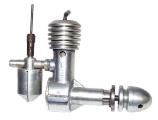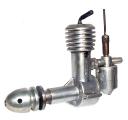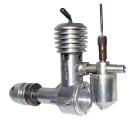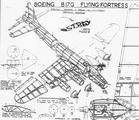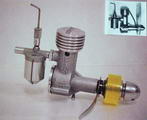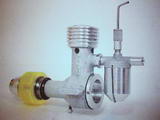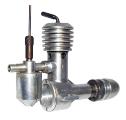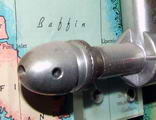| Name | Clan 0.9cc | Designer | unknown |
| Bore | 0.375" (9.53mm) | Stroke | 0.500" (12.7mm) |
| Type | Compression Ignition | Capacity | 0.9cc (0.055 cuin) |
| Production run | unknown | Country of Origin | Scotland |
| Photo by | Tim Dannels, Graham Podd | Year of manufacture | 1947 |
Background
In his A-Z of Vintage and Classic Model Engines, Mike Clanford says the Clan .9cc diesel was first advertised in September, 1947, and wonder of wonders, there it is! A full page in Aeromodeller, placed by kit maker "Astral", showing a price of £5.9.6 which was a princely sum for the time and place. The same page was repeated in the October 1947 issue, but no mention of the engine ever appeared again. In the August 1948 issue, Astral's full page advertisement had a text footnote announcing the "Clan 1.3 with cut-out" at £4.10.0. This, presumably, is the 1.2cc mentioned by Clanford. It was never advertised again, either. And just in case you are confused, Mike Clanford is no relation to the 1947 Clan, but he is related to the 1992 Clan!
Astral had entered the model kit market back in 1939 as the "Atlanta Aero Model Company of Leeds". They changed the name to the "Astral Model Aero Company" in August, 1941 [1] and managed to weather the dark days of World War II, producing scale, rubber powered stick and tissue kits. Despite a post-conflict resurgence which saw them obtain the "sole [UK] rights" to Leon Schulman's "Banshee" pylon design, they faded away in 1949.
Their war time kits included wondrously complex subjects like the four engined Stirling, Halifax, and B17G "Flying Fortress"; twin engine designs like the Bristol Beaufighter and Blenheim, plus other multi and single engine aircraft. With balsa and rubber unavailable after 1941 due to their classification as strategic supplies, Astral kits included a voucher which could be exchanged for rubber, and employed a furry hardwood balsa substitute which was almost totally impervious to knife or razor blade. This gave their kits a reputation as being next to unbuildable, so the cynical might see this as the reason for the rubber voucher scheme—they knew few kits would ever reached the stage where the rubber was required! Regardless, the actual designs, most by the renown Harold J Towner, and Howard Boys, were and remain first class designs, very accurate with respect to scale, and fit of parts.
Versions
As we see here in Astral's second and last promotion of the .9cc Clan, it appears to be a "classic" variable compression, piston ported diesel, and was, so Astral proudly proclaims, "Made by Scots Engineers—The World's Finest". From their ad, it seems Astral had a distribution agreement for England, with sales north of the border managed by "Clan Models", of Glasgow. The advertised engine, like the pristine example depicted in our heading pictures which were kindly provided by ECJ editor, Mr Tim Dannels, employs a conventional contra-piston compression adjustment, but evidence suggests there was another rather different and earlier model.
In his book, the Collectors' Guide to Model Aero Engines, the late Pete Fisher says a "few" Scottish Clan .9cc diesels were made using an eccentric crankshaft bearing for compression adjustment (p29). This is repeated by Bowden in his first edition of Model Diesel Engines (p43). The engine pictured here is an accurate reproduction made by Graham Podd. The insert black and white image appears to be taken from Bowden's first edition book in which he says it was a 1cc engine made by Clan Models of Glasgow. Ron Warring gives the displacement as .9cc in this 1950 book, Miniature Aero Motors, tagging it as no longer in production. The Aeromodeller of May, 1947, mentions the Clan in an article titled "British Diesel Summary", written by Artifex (p361). While he mentions the eccentric bush compression adjustment mechanism and maker, no displacement is quoted, but Artifex says the engine is "on the stocks", presumably meaning, available. The date of this entry suggests that the eccentric compression adjustment model pre-dated the model appearing in the Astral ad and is the best we can do to nail down the order in which the two different versions of the engine were made. It would be churlish to say this is Yet Another Instance where Clanford's A-Z, immensely useful 'though it may be, can be somewhat misleading.
Construction
The drawings from which Graham Podd built the reproduction were prepared by Derek Colin from an original—and very rare—example of the engine. From these, we learn that it had a throw of 0.500" and a bore of 0.375", for a displacement of 0.055cuin, or 0.905cc. The eccentric was 0.015" off-center, providing a total adjustment of 0.030". Unless my math is way off (not a total impossibility), that provides an adjustment of 8:1 in the range of the geometric compression ratio (from about 9:1 to 17:1), which is reasonable.
The eccentric bush was turned from cast iron. The drawings show a 1/32" spring steel adjustment lever which was keyed and soldered to a flange at the front of the bush. The picture from Bowden's book seems to show an angled, threaded rod screwed into the flange, suggesting there was some variation. As drawn, the front of the crankcase journal was split to apply some friction to the adjustment. At least one engine had a clamp ring fitted over the split, but this may not have been original. Graham Podd took a different approach to providing the friction needed to hold the compression setting, using a nylon pad (weed-eater material), pressed against the bush by the screw visible in the photos of his repro engine. Longitudinal retention of the bush was accomplished by the flange at the front and the crankweb at the back, all held together by the prop driver! This was threaded 2BA to screw onto the threaded section of the crankshaft. The latter has a journal diameter of 0.250" and is (obviously) threaded all the way down to the shoulder, making it rather weak at that point. Flats on the rear of the driver allow it to be tightened to the shaft.
The "penny slot" visible in the top of the cylinder jacket tightens the head onto an aluminum compression seal placed in the top of the cylinder with a thin flange acting as a kind of gasket. Transfer is by a single channel milled into the front of the crankcase cylinder bore, just like the later Mills .75. An unusual, and perhaps unique feature of both versions of the engine is the third, rear facing exhaust port. In keeping with the times, the piston is exceptionally long in relation to the bore. This idea was popularized by the designs of Lawrence Sparey—aka "Artifex", mentioned earlier. The theory was that a long piston helped maintain compression at TDC because the gas had further to go when trying to leak past it, and to hell with friction!
From close examination of Tim's original engine and the images in Bowden and Clanford's books, it seems highly likely that the crankcase was a gravity die casting (aka "permould"), polished, with all traces of the die split removed. Notice the fine detail and rounded edges of the tapered mounting lugs. Notice too, the way the lower gusset on Clanford's example contains a casting flaw typical of a cold die. Note too that the tank top and venturi is different on each of the three examples of the original engine.
The thinking behind the "extra" exhaust port is obscure, but remember that early 1947 was pioneering time for engines of this type. The designer probably had a grand theory, but we are at a loss to think what it may have been. That it made life difficult for him is seen here by the way he had to lower the crankcase venturi boss off-center from the cylinder liner inlet port to accommodate his rear exhaust port. But he's not alone here; Mills Bros ended up with the same arrangement when they decided to increase the inlet duration without altering the external configuration of the 1.3. On these old, low-revving piston ported diesels, it seems that a dog-leg inlet path just does not matter.
The spinner nut is a bit unusual too. It has the "starting cord pully groove" popular at the time (see the Dyno, AMCO .87, Kalper .32cc, Allbon 2.8, the K Hawk .2cc and K Eagle 1cc, ED 2cc "Penny-slot", etc), and is drilled all the way through for some reason. Even the knurling on Tim's needle valve thimble is out of the ordinary, having been produced either by a single diamond knurl, or a straight one set at an angle! I could say that the rest of the engine is completely "standard", but I think the only thing left is the backplate.
Conclusion
We've saved the best for last. Recall Astral's boast that the Clan was made by "Scots Engineers—The World's Finest"? During his research into the origins of the Rowell 60 engines, our Adrian Duncan discovered the identity of the people responsible for making the Clan. It was actually manufactured by an outfit called Kingdom Models, whose manufacturing facility was housed in a converted cowshed in the quaintly-named town of Coaltown of Wemyss in Fife. The Rowell engines were manufactured under contract to Rowell Motors, and presumably the Clan engines were manufactured under a similar contractual arrangement.
As far as we know, very few were made and the engine is exceptionally rare today. The division in production between eccentric bush and "standard" contra-piston models is not known. The data on this page is based on inspection of photos and research into old magazines. It's possible, likely even, that we've got something wrong. If you can provide authoritative corrections, or further information, we are always pleased to receive, revise, and confess.
References:
| [1] | Imrie, Alex: Vintage Corner, Aeromodeller, Volume 58, Number 689, Argus Specialist Publications, GB, June 1993, p8. |
![]()
